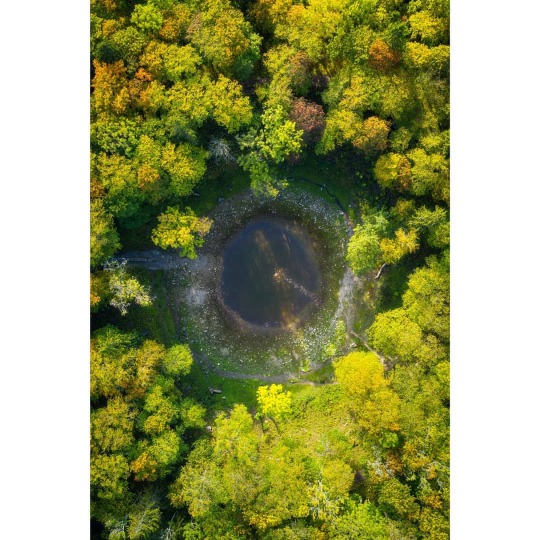#kaali crater
Text

Legends and myths about trees
Forest myths, Estonian traditional beliefs (3)
The world of the Estonians’ ancestors – Kaali crater, the place where "The sun went to rest"
Kaali is a group of nine meteorite craters in the village of Kaali on the Estonian island of Saaremaa. It was created by an impact event. The largest crater is 110 m (360 ft) in diameter and forms a small lake named Lake Kaali.
The impact is thought to have happened in the Holocene period, around 3,500 years ago. The estimates of the age of the Kaali impact structure provided by different authors vary by as much as 6,000 years, ranging from ~6,400 to ~400 years before current era (BCE). According to the theory of more recent impact, Estonia at the time of impact was in the Nordic Bronze Age and the site was forested with a small human population. The impact energy of about 80 TJ (20 kilotons of TNT) is comparable with that of the Hiroshima bomb blast. It incinerated forests within a six km (3.7 mi) radius.
The event figured prominently in regional mythology. It was, and still is, considered a sacred lake. There is archaeological evidence that it may well have been a place of ritual sacrifice.
It is possible that Saaremaa was the legendary Thule island, first mentioned by ancient Greek geographer Pytheas, whereas the name "Thule" could have been connected to the Finnic word tule ("(of) fire") and the folklore of Estonia, which depicts the birth of the crater lake in Kaali. Kaali was considered the place where "The sun went to rest."
[Image below: the crater as viewed from near the rim]

森の神話・エストニアの民間伝承 (2)
エストニア人の祖先の世界 〜 "太陽が休息する場所 "、カーリー・クレーター
カーリ・クレーターは、エストニアのサーレマー島にある9個の隕石クレーター群である。このクレーター (噴火口) は衝突現象によって形成されたものでである。最も大きいクレーターは直径110mでカーリ湖という名の小さな湖になっている。
この衝突は完新世、およそ3,500年前に起こったと考えられている。カーリ衝突構造の推定年代は、著者によって6,000年も異なっており、現在の時代 (紀元前) より6,400年前から400年前までである。より最近の衝突説によれば、衝突当時のエストニアは北欧青銅器時代で、この地は森林に覆われ、小規模な人間しか住んでいなかった。約80TJ (TNT20キロトン)という衝撃エネルギーは、広島原爆の爆風に匹敵する。半径6km (3.7マイル) の森林を焼却した。
この出来事は、この地域の神話において重要な位置を占めている。昔も今も、この湖は神聖な湖と考えられている。儀式の生贄の場所であった可能性を示す考古学的証拠もある。
サーレマー島は古代ギリシャの地理学者ピュテアスが最初に言及した伝説上のトゥーレ島であった可能性があり、一方、「トゥーレ」という名前はバルト・フィン諸語のトゥーレ (“火の”の意) や、カーリにある火口湖の誕生を描いたエストニアの民間伝承と結びついている可能性がある。カーリは "太陽が休息する場所 "と考えられていた。
#trees#tree legend#tree myth#kaali#saaremaa#estonia#estonian mythology#kaali crater#impact event#tule#nature#art#mythology#legend#folklore
118 notes
·
View notes
Text
List of impact craters on Earth
some light reading for you
#chicxulub my beloved#but the kaali craters get a special mention for apparently being recorded by estonian folklore
1 note
·
View note
Text
wikipedia tabs i have open on new year's day
Railgun
Gunboat
Loess
Kamchatka Peninsula
Ansible
Hainish Cycle
Key deer
Mount Rainier
Socialism with Chinese characteristics
Xi Jinping Thought
Historical nihilism
Three Represents
Scientific Outlook on Development
Blue crab
Callinectes sapidus
Crab cake
Diamondback terrapin
Turtle soup
Yellow-bellied slider
Red-eyed slider
Littoraria irrorata
Halite
Appanage
Princess
Penicillin
Raffinate
Kaali crater
Hittite mythology and religion
Augury
Dovecote
Fasenjān
Confucianism
Messier 87
Elliptical galaxy
Whirpool Galaxy
Spiral galaxy
Pinwheel Galaxy
Milky Way
Sagittarius A*
Messier 87
History of Christian universalism
Kardashev scale
Grand duke
PSR B1257+12
PSR B1257+12 B
55 Cancri e
Carbon planet
Chthonian planet
Tholin
Luna (goddess)
European rabbit
Heroin
Abscess
Acedia
Weltschmerz
Razor
Synthetic fiber
Marshal of Yugoslavia
65 notes
·
View notes
Text
someone wit kaali crater header reblogged my pinkie image. Do they know i have been there Hehehhee they don't
1 note
·
View note
Photo

Death from space Tens of tons of extraterrestrial solid material collide with Earth daily. Most of this material is small enough that it burns up in the atmosphere, but some fragments are large enough to cause quite a predicament. In 2013, a 20-meter-diameter body exploded over Chelyabinsk, seriously injuring more than 1,500 people. The most recent impact crater on Earth was formed in 2007, when an asteroid crashed into a small village in Peru. A 1947 asteroid impact in far-eastern Russia resulted in the formation of the youngest crater-strewn field on our planet: Sikhote-Alin. The most impressive, relatively recent, extra-terrestrial event happened in 1908, when a body exploded over Siberia, flattening 2000 km2 of forest. We can prepare for this natural hazard only if we understand how often these kinds of small impacts happened in the past and how they influenced the environment. A new article in the Geological Society of America’s journal Geology shows that analyzing bodies of organisms killed by an impact of asteroids can teach us exactly how much damage occurs at the spot of such a cosmic collision. The research team dug out trenches in rims of four craters (Kaali Main and Kaali 2/8 in Estonia, Morasko, in Poland, and Whitecourt in Alberta, Canada), located on two different continents that formed thousands of years apart. Dr. Jüri Plado and Dr. Argo Jõeleht noticed, “Surprisingly, in all those places we found the same thing: millimeter- to centimeter-sized pieces of charcoal intermixed within material ejected during its formation and located at the same place in respect to the crater. Dr. Ania Losiak, the lead author of this study, from the Institute of Geological Sciences, Polish Academy of Sciences, and the University of Exeter, said, “At first we thought those charcoals were formed by wildfires that occurred shortly before the impact, and charcoals just got tangled in this extraterrestrial situation. But something was not right with this hypothesis—there were too many coincidences; why would there be large wildfires shortly before formation of four different small impact craters divided by thousands of kilometers and years? Why would it be found only in a very specific location within the proximal ejecta blanket? It made no sense, so we decided to investigate further and analyze properties of charcoal pieces found intermixed within material ejected from craters and compare it with wildfire charcoals.” Like bodies studied in a criminal investigation, the properties of organic remnants turned into charcoal reflect the conditions in which they were killed. Based on their properties, we can clearly recognize charcoals formed as a result of a wildfire and those found within proximal ejecta of impact craters. Professor Claire Belcher from the University of Exeter explained, “Impact charcoals are really weird: They were all formed in much lower temperatures than wildfire charcoals, they lack sections that were formed while directly touching the flame, and they are all very similar to each other, while in a fire it is common to find strongly charred wood just next to barely affected branches.” “This is definitely not what we expected when we started this study: We think that impact charcoals were formed when fragments of trees shattered by the impact were intermixed with local material ejected from the crater,” added Losiak. “This study improves our understanding of environmental effects of small impact crater formation so that in the future, when we discover an asteroid a few meters across or more coming our way only a couple of weeks before the impact, we will be able to more precisely determine the size and type of evacuation zone necessary,” said Professor Chris Herd from the University of Alberta. “Our research may also help to find new impact craters on Earth; we expect that we are missing from our records more than ten craters formed within the last ten thousand years. We need to find them, before their relatives visit us unexpectedly,” explained professor Witek Szczuciński from Adam Mickiewicz University in Poznan. IMAGE....Digital elevation model of Kaali craters (by Argo Jõeleht). CREDIT Argo Jõeleh
0 notes
Text

© Krivinis via Getty Images
6. KAALI CRATER FIELD
– Location: Kaali, Estonia
– Diameter: Largest crater 360 ft (110 meters)
– Depth: Largest crater 72 ft (22 meters)
– Age: Estimates ranging from 8400 to 2420 years old
Why visit one crater when you can visit nine? Located on Saaremaa, Estonia's largest island, the Kaali crater field lies 11 miles (18 km) from the island capital which consists of one large crater and eight smaller craters according to the news site The Baltic Times.
Remarkably, the island is thought to have already been inhabited at the time of the meteorite impact approximately 1530-1549 BCE according to a study published in Meteoritics and Planetary Science, though the age is still a matter of debate and estimates range from 2,420 years to 8,400 years old.
The scientific and cultural significance of the Kaali crater field can be explored in great detail at the Kaali Meteoritics and Limestone Museum. Here you can also view various fossils on display and learn about other discoveries made on the island of Saaremaa. A guide service is available in Estonian, English, Finnish and Russian and there is also a gift shop.
0 notes
Photo

Kaali Crater
3500 years ago, this would have been a bad place to be. This is Kaali crater, a small impact crater in the nation of Estonia. This is the largest of 9 different craters found in a 1 kilometer area; they were produced when a piece of an iron asteroid entered Earth’s atmosphere, broke up into pieces due to frictional forces in Earth’s atmosphere, and then impacted the ground and exploded.
The impact had enough energy to burn parts of whatever forest existed at the time, leaving behind charcoal mixed with debris from the impact that could be dated using Carbon-14 radioisotope measurement techniques. That age shows that this crater formed about 3500 years ago or about 1500 BCE. There were almost certainly people in this area at the time to witness this event.
-JBB
Image credit: James St. John
https://flic.kr/p/F5JJQa
Paper reference:
https://onlinelibrary.wiley.com/doi/full/10.1111/maps.12616
592 notes
·
View notes
Text


#last time i came here was w my class & i felt too sick then & stayd in the bus..#meteor crater kaali
2 notes
·
View notes
Text

Kaali meteorite crater lake
696 notes
·
View notes
Text

[Image above+below: works of an Estonian artist, Kaljo Põllu (28 November 1934 – 23 March 2010) ]
Legends and myths about trees
Forest myths, Estonian traditional beliefs (2)
The world of the Estonians’ ancestors - Proto-Estonian mythology
The world of the Estonians’ ancestors is believed to have turned around a pillar or a tree, to which the skies were nailed with the North Star. The Milky Way (Linnutee or Birds' Way in Estonian) was a branch of the World tree (Ilmapuu) or the way by which birds moved (and took the souls of the deceased to the other world). These myths were based on animistic beliefs.
Some traces of the oldest authentic myths may have survived in runic songs. There is a song about the birth of the world – a bird lays three eggs and starts to lay out the nestlings – one becomes Sun, one becomes Moon and one becomes the Earth. Other Finnic peoples also have myths according to which the world has emerged from an egg.
It has been suggested by ethnologist and former president Lennart Meri and among others, that a Kaali meteorite crater which passed dramatically over populated regions and landed on the island of Saaremaa around 3,000 - 4,000 years ago was a cataclysmic event that may have influenced the mythology of Estonia and neighboring countries, especially those from whose vantage point a "sun" seemed to set in the east.
There are surviving stories about Kaali crater in Finnish mythology (Description of indigenous paganism by Finns who always believed in spirit beliefs).
In the Karelian-Finnish folk epic, the Kalevala, cantos (songs) 47, 48 and 49 can be interpreted as descriptions of the impact, the resulting tsunami and devastating forest fires. It has also been suggested that the Virumaa-born Oeselian god Tharapita is a reflection of the meteorite that entered the atmosphere somewhere near the suggested "birthplace" of the god and landed in Oesel.
Estonian mythology is a complex of myths belonging to Estonian folk heritage and literary mythology, and the systematic documentation of Estonian folklore had only began in the 19th century.
Therefore, information on Proto-Estonian mythology before the conquest of the Northern Crusades, Christianisation and incorporation into the European world and during the medieval era, is only scattered in historical chronicles, travellers' accounts and in ecclesiastical registers.
It can be difficult to tell how much of Estonian mythology as we know it today was actually constructed in the 19th and early 20th century. Friedrich Robert Fehlmann, one of the compilers of the Estonian national epic, Kalevipoeg in the introduction to Esthnische Sagen (Estonian Legends), states.
"However, since Pietism has started to penetrate deep into the life of the people...singing folk songs and telling legends have become forbidden for the people; moreover, the last survivals of pagan deities are being destroyed and there is no chance for historical research."

木にまつわる伝説・神話
森の神話・エストニアの民間伝承 (2)
エストニア人の祖先の世界 〜 原始エストニア神話
エストニア人の祖先の世界は、柱または木の周りを回っていたと信じられており、その柱には北極星とともに天空が釘付けにされていた。天の川(エストニア語ではリヌーテーまたは鳥の道)は世界樹(イルマプー)の枝であり、鳥が移動する(そして亡くなった人の魂をあの世に連れて行く)道であった。これらの神話はアニミズム的な信仰に基づいていた。
最古の本物の神話の痕跡が、ルーン文字の歌詞の中に残っているかもしれない。ある鳥が3つの卵を産み、雛を産み始める。ひとつは太陽になり、ひとつは月になり、ひとつは地球になる、という世界の誕生の歌がある。他にはフィン族にも、世界が卵から生まれたという神話がある。
3,000~4,000年前に人口密集地域の上空を劇的に通過し、サーレマー島に落下したカーリ隕石 (カーリ・クレーター) は、エストニアや近隣諸国、特に「太陽」が東に沈むように見えた国々の神話に影響を与えた可能性がある、と民族学者で元大統領のレンナルト・メリらによって示唆されている。
フィンランド神話 (精霊信仰を常に信仰していたフィン族による原始宗教的な伝説) にカーリ隕石に関する物語が残っている。カレリア・フィンランドの民俗叙事詩『カレワラ』の第47、48、49カント (聖歌) は、その衝撃と、その結果生じた津波、壊滅的な森林火災についての記述であると解釈できる。また、ヴィルマア生まれのオイセルの神タラピタは、この神の「出生地」とされる場所の近くで大気圏に突入し、オイセルに落下した隕石の反映であるとも言われている。
エストニア神話は、エストニアの民間伝承と文学的神話に属する神話の複合体であり、エストニアの民間伝承の体系的な記録が始まったのは19世紀になってからである。そのため、北方十字軍の征服、キリスト教化、ヨーロッパ世界への併合以前、そして中世のエストニア神話の原型に関する情報は、歴史年代記、旅行者の記録、教会の記録に散見されるのみである。
今日私たちが知っているエストニア神話のどれだけが、19世紀から20世紀初頭にかけて実際に構築されたものなのかを見分けるのは難しい。エストニアの民族叙事詩『カレヴィポエグ』の編纂者の一人であるフリードリヒ・ロベルト・フェールマンは、『エストニア伝説』の序文で次のように述べている。
“しかし、敬虔主義が人々の生活に深く浸透し始めて以来......民謡を歌い、伝説を語ることは、人々にとって禁忌となった; さらに、異教の神々の最後の生き残りは破壊されつつあり、歴史研究のチャンスはない。"
#trees#tree myth#tree legend#legend#mythology#folklore#estonian mythology#finnish mythology#kalevala#paganism#animism#north star#milky way#birds' way#world tree#nature#art#Kaljo Põllu#spirit beliefs#estonia
115 notes
·
View notes
Photo

Kaali Meteorite Crater... one of 9 meteorite craters in the village of Kaali on the Estonian island of Saaremaa. Most recent estimates put its formation shortly after 1530–1450 BC via /r/space http://ift.tt/2p1jXd0
#reddit#Kaali Meteorite Crater... one of 9 meteorite craters in the village of Kaali on the Estonian
6 notes
·
View notes
Photo

In diesem kleinen Wäldchen auf der Insel Saaremaa in Estland ist vor etwa 7,5 Tausend Jahren ein Meteorit eingeschlagen. Er war das größte mehrerer Bruchstücke, die in der Region niedergegangen sind. Der Legende nach passierte dies, weil ein Geschwisterpaar geheiratet hat. Also, Augen auf bei der Partnerwahl 🤣 #visitestonia #saaremaa #estonia #kaali #crater #meteor #landscape #travel #photocrowd #weroamgermany #balticnature #balticsinmycolors #balticstates #bestofthebaltics #baltictrip #justgoshoot #germanroamers #thewanderco #roamtheplanet #earthfocus #discoverglobe #awesomeglobe #exploretocreate #igerscz #discoverearth #fotokochfan #liveforthestory #YourShotPhotographer #viewbug https://www.instagram.com/p/B8zP2F_o82G/?igshid=tq00em991842
#visitestonia#saaremaa#estonia#kaali#crater#meteor#landscape#travel#photocrowd#weroamgermany#balticnature#balticsinmycolors#balticstates#bestofthebaltics#baltictrip#justgoshoot#germanroamers#thewanderco#roamtheplanet#earthfocus#discoverglobe#awesomeglobe#exploretocreate#igerscz#discoverearth#fotokochfan#liveforthestory#yourshotphotographer#viewbug
0 notes
Text
Estonian Travel & Tipple at Saaremaa
One of the best sightseeing destination in Europe, Estonia excels in all around activities a tourist would love to indulge. Though not a Nation of alcoholics the country produces the finest beverages and craft liquors.

On tour do not forget to visit the salient confines of Saaremaa the largest island in Estonia. Pristine land is a biosphere reserve comprising of amazing flora and fauna. And while in Saaremaa drop in at Lahhentagge Distillery to savor the finest craft gin Osel and gin alternatives like Flaneur and Flaneuse.

Tipple goes well with Estonic Tonic Soda available in many flavors. Cocktails excel in taste and aroma whence mixed with Osel Gin or Flaneur or Flaneuse both sans alcohol but spirited flavors of fresh juniper and botanicals.

Drinks deliver the gist of experience while on travel. At Saaremaa you can visit the museum and Kuressaare Castle, Kaali Meteor Crater, Vislandi National Park or go on a hiking trail in the wilds. There are many more places in the island to visit during your stay in Saaremaa before you move further in this esoteric Baltic Country.

The Kuressaare Castle houses the museum dedicated to history and nature. The castle was built in the 14th Century and fuels your fantasy with amazing structures like the chambers, halls, passages, pathways and mega stairs. The architectural splendor exhibits European style of royal buildings. While in the dungeon hear the terrific roars of the lions as they did in ancient times whence prisoners were devoured. When you stand on the top floor you are mesmerized by view of the bay and the countryside.

While enjoying you drinks do savor the Estonian gastronomic delights. The country is known for some of the finest cuisine in Europe, and you should try recipes.


youtube
2 notes
·
View notes
Photo

3/5/21: r/SketchDaily theme, "March Into Landscapes: Saaremaa, Estonia." Kaali Crater, Saaremaa, Estonia.
(Follow THIS TAG for my previous March Into Landscapes attempts!)
[March Into Landscapes: Saaremaa, Estonia [Friday, March 5, 2021, 8:36:21 PM]]
1 note
·
View note
Photo

Kaali meteorite crater, Estonia [OC] [4608x2184]
3 notes
·
View notes
